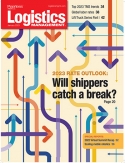USPS sees revenue gain but net losses remain intact in fiscal second quarter earnings
At $17.5 billion, USPS revenue headed up $235 million, or 1.4%, compared to the fiscal second quarter of 2017, but it incurred a net loss of $1.3 billion for the quarter compared to a net loss of $562 million a year ago

Logistics in the News
Intermodal volumes finish 2022 with declines, reports IANA U.S. rail carload and intermodal volumes are mixed, for week ending January 14, reports AAR Single-Carrier vs. Multi-Carrier Shipping Stategies 论坛流动性heralds $400M joint venture with CBRE IM and Series A funding round Catching up with MHI’s Daniel McKinnon 更多的物流消息Logistics Resource
Single-Carrier vs. Multi-Carrier Shipping Stategies Download the white paper to learn about the benefits of multi-carrier shipping with EasyPost.
Download the white paper to learn about the benefits of multi-carrier shipping with EasyPost.All Resources
Fiscal second quarter earnings for theUnited States Postal Service (USPS)brought something that was welcome and has often been missing in previous earnings announcements, an increase in total revenue.
At $17.5 billion, USPS revenue headed up $235 million, or 1.4%, compared to the fiscal second quarter of 2017.
USPS cited another strong quarter for its Shipping and Packages group, which saw revenue rise by $445 million, or 9.5%, to $5.152 billion, along with package volume up 69 million pieces, or 5%, to 1.458 billion.
Parcel Services volume was up 5.4% to 732,000, and Package Services volume was up 2.6% to 156,000. USPS said in its Form 10-Q statement that Parcel Services volume gains were paced largely by the continuing growth of e-commerce, with the caveat that this subcategory is mainly a “last-mile” service that “bypasses much of our infrastructure and therefore is one of our lowest-priced package services, and as a result, produces a lower yield per piece when compared to many of our other services.”
USPS First-Class and Marketing revenue dropped by a combined $118 million, with mail volumes down 2.1%, or 700 million pieces, annually.
Even though First-Class and Marketing comprises a significant amount of USPS revenue, although the USPS Form 10-Q noted , even though there are intact long-term trends away from hard-copy communication to electronic media, which has resulted in significant First-Class Mail declines over the last decade. Marketing Mail, it said, has been relatively steady over the same period, even though its volume has fallen at a steeper rate beginning in 2017 and remaining in the same pattern to the present day.
While revenue was in the black for the USPS, it was not all positive news, with the organization saying:
- its quarterly controllable loss was $656 million, which was significantly steeper than the $12 million in controllable income a year ago, with the change in controllable income due to a $236 million increase in the controllable portion of the normal cost of retiree health benefits due to changes in actuarial assumptions, a $364 million increase in compensation expenses due to additional hours incurred to support the labor-intensive package business as well as contractual wage adjustments, and transportation expenses rising by $155 million due to highway contract rate inflation as well as higher fuel costs;
- a net loss of $1.3 billion for the quarter compared to a net loss of $562 million a year ago;
- total operating expenses up $1 billion, or 5.7%, to $18.8 billion; and
- unfunded retirement and retiree health benefits up a cumulative $766 million
“Despite growth in our package business, our financial results reflect systemic trends in the marketplace and the effects of an inflexible, legislatively mandated business model that limits our ability to generate sufficient revenue and imposes costs upon us that we cannot afford,” said Postmaster General and CEO Megan J Brennan in a statement. “America needs a financially strong Postal Service that can invest in its future and can continue to fulfill the needs of American businesses and consumers. With continued aggressive management and greater legal authority to respond to changes in our marketplace and to control our costs, the Postal Service can return to financial sustainability.”
Jerry Hempstead,president of Hempstead Consulting, said that even though there is strong growth in the USPS’s Shipping and Packages group, it is not enough to overcome the quarterly losses USPS is incurring.
“When the current Parcel strategy was fleshed out there, were very liberal assumptions about cost allocation to the product,” he said. First-Class mail was doing the heavy lifting, so it was burdened with more of the institutional costs (like letter carriers, delivery vehicles, post offices and so on). The dynamics have shifted dramatically over the last decade with the extraordinary decline of First-Class and the incredible growth of parcel. The USPS has said that parcel is far more labor intensive than First-Class to handle. What we are to read between the lines is that ‘yes, parcels are growing in transactions and revenue, but the revenue may not be covering the incremental costs associated with this particular product offering. The President has also commented on this aspect.”
Assessing what needs to happen going forward, Hempstead said that when the cost allocation process is debated between the USPS and the Postal Regulatory Commission, there might be a need to update the prices of the postal products.

About the Author
 Jeff Berman, Group News EditorJeff Berman is Group News Editor for万博2.0app下载,Modern Materials Handling, andSupply Chain Management Review. Jeff works and lives in Cape Elizabeth, Maine, where he covers all aspects of the supply chain, logistics, freight transportation, and materials handling sectors on a daily basis.Contact Jeff Berman
Jeff Berman, Group News EditorJeff Berman is Group News Editor for万博2.0app下载,Modern Materials Handling, andSupply Chain Management Review. Jeff works and lives in Cape Elizabeth, Maine, where he covers all aspects of the supply chain, logistics, freight transportation, and materials handling sectors on a daily basis.Contact Jeff Berman

Subscribe to Logistics Management Magazine!
Subscribe today. It's FREE!Get timely insider information that you can use to better manage your entire logistics operation.
Start your FREE subscription today!
 Single-Carrier vs. Multi-Carrier Shipping Stategies
Download the white paper to learn about the benefits of multi-carrier shipping with EasyPost.
Download Today!
Single-Carrier vs. Multi-Carrier Shipping Stategies
Download the white paper to learn about the benefits of multi-carrier shipping with EasyPost.
Download Today!
 Our annual gathering of freight transportation industry analysts reveals some common themes, largely around the notion that rates are not likely to increase much—if at all—in some modes and will continue declining in others. Does this mean things are stabilizing?
Our annual gathering of freight transportation industry analysts reveals some common themes, largely around the notion that rates are not likely to increase much—if at all—in some modes and will continue declining in others. Does this mean things are stabilizing?LM Viewpoint on the 2023 Rate Outlook: Will shippers catch a break? Global Labor Rates: China is no longer a low-cost country View More From this Issue
 2023 Rate Outlook Webcast: Will shippers catch a break?
In this annual webcast, group editorial director Michael Levans hosts our panel of logistics and freight transportation analysts who share their insights on rate patterns in all the major transport modes in an effort to help shippers prepare their freight transportation budget for the coming year.
Register Today!
2023 Rate Outlook Webcast: Will shippers catch a break?
In this annual webcast, group editorial director Michael Levans hosts our panel of logistics and freight transportation analysts who share their insights on rate patterns in all the major transport modes in an effort to help shippers prepare their freight transportation budget for the coming year.
Register Today!








